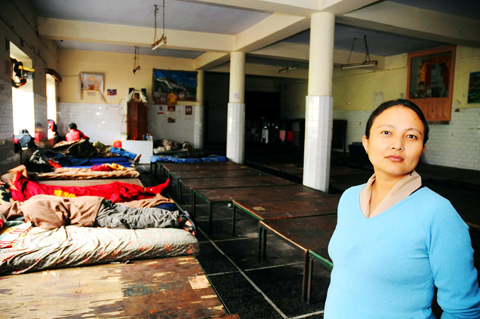The Tibetan community in exile headed by the Dalai Lama is a constant irritant for China, but Beijing has hit upon a way to weaken the movement: starve it of new arrivals.
An almost empty dormitory in the gloomy main reception center for Tibetan exiles in Dharamsala, the Indian hilltown home to the community, is a graphic illustration of changes that have taken place over the last 18 months.
India has sheltered Tibetans since 1959, when the Dalai Lama fled his homeland in fear for his life after a failed uprising against Chinese rule on the strategic Tibetan plateau.

PHOTO: AFP
Since then, thousands of others have made the same treacherous trip to Dharamsala, mostly via Nepal across snow-capped mountains on foot and horseback, swelling the ranks of the population abroad to an estimated 200,000.
But today, fewer and fewer people are getting out.
“Up until March 2008, we used to have about 2,500 to 3,000 people arriving here per year,” said Mingyur Youdon, the deputy director of the reception center in McLeod Ganj, the uppermost part of Dharamsala. “Since February 2008, we’ve received only about 1,000.”
Her building is the sorting center for new arrivals where they are offered beds, food, financial help, information on schooling if necessary, and, most importantly for some, an audience with the Dalai Lama.
The drabness of the building is punctuated with pictures of the smiling 75-year-old spiritual leader, whose residence sits in an isolated spot just outside the town with a panoramic view of the valley below.
A woman wailing with grief in the female dormitory is testament to the emotional hardship of a life in exile.
THE CRACKDOWN
In March 2008, the date when arrivals in Dharamsala began falling, the capital of Tibet was convulsed by a wave of violent protests against Chinese rule that left an unknown number of people dead and injured.
China says 22 people died in the violence, which spread from Lhasa across Tibet and neighboring regions with large populations of ethnic Tibetans.
The Tibetan government-in-exile says more than 200 died and 1,000 were hurt.
Following the violence, China tightened its already firm grip on the region by sending reinforcements and clamping down on anyone suspected of dissent or fomenting unrest.
Increased border controls are a consequence and Beijing has also leant heavily on Nepal, the tiny republic wedged between Tibet and India, to arrest anyone fleeing the region.
“We are deeply disappointed with the authorities in Kathmandu,” spokesman for the Tibetan government in exile, Thubten Samphel, said from his office in one of the many neat buildings used by the administration.
“Our disappointment stems from the realization that Nepal is so vulnerable to Chinese pressure,” he said.
He says monitoring has increased on the Tibet-Nepal border, which is nowadays the only way out for those wanting to flee, and claims that Chinese police routinely enter Nepalese territory to pursue refugees.
“The most important reason for the restrictions is to prevent information going out to the outside world regarding the oppression going on in Tibet,” he says.
COSTLY ESCAPES
In the male dormitory of the reception center, where only a quarter of the 70 beds are full, a group of monks and other recent escapees mill around, wary to speak to a reporter for fear of reprisals back home.
Those willing to talk explain how the price has tripled to be guided over the border: before March 2008, it cost about 5,000 yuan (US$737) to 6,000 yuan, today the increased risk means smugglers demand 15,000 yuan and more.
One 15-year-old monk, who spoke passionately about his desire to return home one day to help his compatriots, had paid 21,000 yuan. He arrived two weeks ago and said his trip entailed seven days of walking in the dead of night.
“They have put extra forces in Tibet. Everytime we go outside, the Chinese police are always watching us, especially the monks,” he said.
“At present, the situation inside Tibet is very tense. I escaped to India to get a traditional religious education,” the monk said.
On the other side of McLeod Ganj in a steep valley sits the sprawling Tibetan school, where around 2,000 children of all ages study on a campus where basketball is taught alongside traditional Tibetan opera.
FEWER PUPILS
Despite the evidence of US sports here, the curriculum is designed to instill a sense of nationhood in young Tibetans with emphasis placed on their long cultural history and unique language.
The views are breathtaking, with high snow-capped Himalayan peaks behind and miles of rolling hills in front that eventually give way to the vast sun-baked Indian Gangetic plain.
“The number joining us from Tibet has decreased noticeably,” school director Phuntsok Namgyal said. “We used to get 700-800 children every year on average and since 2008 the number has reduced considerably.”
“It’s very obvious that fewer children can make their way to India,” he said.
He estimates only 250 children have enrolled in the school in the last 18 months, an ominous sign for a movement determined to protect Tibetan culture and fight for Tibetan independence or autonomy under Chinese rule.
The pioneers who came in 1959 are well past retirement age and, like the Dalai Lama, will one day be gone.
“It’s a serious concern for all of us,” Namgyal said.

Nauru has started selling passports to fund climate action, but is so far struggling to attract new citizens to the low-lying, largely barren island in the Pacific Ocean. Nauru, one of the world’s smallest nations, has a novel plan to fund its fight against climate change by selling so-called “Golden Passports.” Selling for US$105,000 each, Nauru plans to drum up more than US$5 million in the first year of the “climate resilience citizenship” program. Almost six months after the scheme opened in February, Nauru has so far approved just six applications — covering two families and four individuals. Despite the slow start —

MOGAMI-CLASS FRIGATES: The deal is a ‘big step toward elevating national security cooperation with Australia, which is our special strategic partner,’ a Japanese official said Australia is to upgrade its navy with 11 Mogami-class frigates built by Japan’s Mitsubishi Heavy Industries, Australian Minister for Defence Richard Marles said yesterday. Billed as Japan’s biggest defense export deal since World War II, Australia is to pay US$6 billion over the next 10 years to acquire the fleet of stealth frigates. Australia is in the midst of a major military restructure, bolstering its navy with long-range firepower in an effort to deter China. It is striving to expand its fleet of major warships from 11 to 26 over the next decade. “This is clearly the biggest defense-industry agreement that has ever

DEADLY TASTE TEST: Erin Patterson tried to kill her estranged husband three times, police said in one of the major claims not heard during her initial trial Australia’s recently convicted mushroom murderer also tried to poison her husband with bolognese pasta and chicken korma curry, according to testimony aired yesterday after a suppression order lapsed. Home cook Erin Patterson was found guilty last month of murdering her husband’s parents and elderly aunt in 2023, lacing their beef Wellington lunch with lethal death cap mushrooms. A series of potentially damning allegations about Patterson’s behavior in the lead-up to the meal were withheld from the jury to give the mother-of-two a fair trial. Supreme Court Justice Christopher Beale yesterday rejected an application to keep these allegations secret. Patterson tried to kill her

North Korean troops have started removing propaganda loudspeakers used to blare unsettling noises along the border, South Korea’s military said on Saturday, days after Seoul’s new administration dismantled ones on its side of the frontier. The two countries had already halted propaganda broadcasts along the demilitarized zone, Seoul’s military said in June after the election of South Korean President Lee Jae-myung, who is seeking to ease tensions with Pyongyang. The South Korean Ministry of National Defense on Monday last week said it had begun removing loudspeakers from its side of the border as “a practical measure aimed at helping ease